Actuel Dogs bills itself as the first luxury dog hotel in France, and claims its facilities and staff are everything your pooch needs to feel pampered.
Located on the outskirts of Paris, in the chic suburb of Vincennes, this four-star establishment for pets is the brainchild of Devi and Stan Burun, a dog behaviour specialist and a lifelong dog-lover. Unlike similar luxury facilities in the US or Japan, Actuel Dogs tries to cater to dogs’ needs. “It’s not like in the United States or – giving the dogs manicures, dying their fur pink — that’s human madness. Our priority is to meet the dogs’ needs,” Devi says, adding that “people think we serve the dogs’ food from silver platters but this is not pointless, extravagant luxury.”
People who live in small apartments and don’t have the walk or look after their pets, bring them to Actuel Dogs, where they’ll get all the comfort and attention they crave. Here they enjoy a dip in the pool, relaxing massages, fine cuisine meals, calming walks through the nearby woods, and loads of other fun activities. When it’s time for a nap, canines are escorted to one of the hotel’s six rooms, adorned with soft cushions, framed dog prints and LCD Tvs, so they can watch their favorite DVDs.
Before they book their first stay, dogs are evaluated for aggressive behaviour, and if they pass they will enjoy a “concept that is human, but it’s completely adapted to dogs’ needs.” Prices for a day at Actuel Dogs hotel vary between 26 and 35 euros ($36 – $48), but the luxury treatment and the fact that dogs aren’t kept in uncomfortable cages makes owners fork out the cash.





















